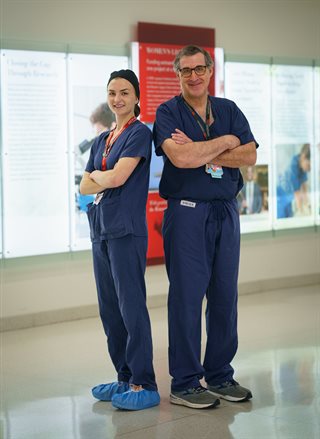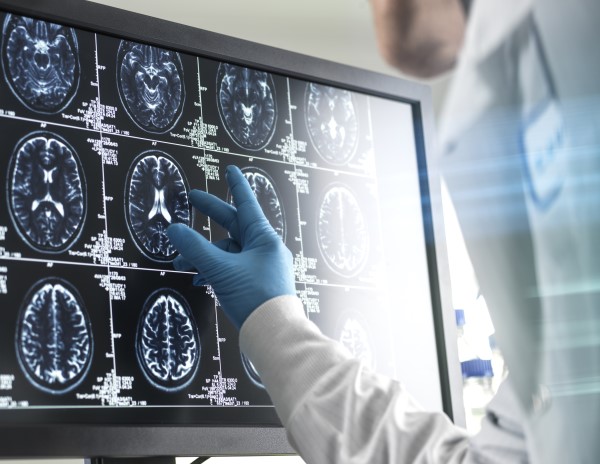Editor's note: The original version of this article by Carle Illinois College of Medicine can be found here. Photos provided by Carle Illinois College of Medicine.
New research may unlock clues that improve detection of concussions in young athletes. The results could lead to improved diagnosis and better decisions on when it’s safe for an athlete to return to play.
The research is a collaboration between Carle Illinois College of Medicine and Carle Health. It is being led by CI MED student Annabelle Shaffer and Clinical Sciences professor and neurosurgeon Dr. Paul Arnold and includes clinical experts from CI MED and Carle Health along with researchers from the University of Illinois Urbana-Champaign’s Beckman Institute. The team is leveraging a large patient database to establish baseline data for assessing concussion symptoms among high school athletes.
“This normative data can be used by high school athletics staff to detect concussions in their athletes, even if they do not have individual baselines to compare to. Additionally, since our sample is so large, we can provide expected variation based on student characteristics,” Shaffer explained.
 Typically, athletes who sustain a head injury undergo concussion screening, which involves measuring physical and mental skills such as balance, memory, concentration, and problem-solving. In professional or college athletes, post-injury results are often compared to the athlete’s pre-injury assessments. However, for high school athletes, such baseline data may not be available. By tapping into patient records from three thousand young athletes across a range of sports and 19 central Illinois high schools, the research team is bridging the gap with statistically derived normative data that is broken down by age and gender.
Typically, athletes who sustain a head injury undergo concussion screening, which involves measuring physical and mental skills such as balance, memory, concentration, and problem-solving. In professional or college athletes, post-injury results are often compared to the athlete’s pre-injury assessments. However, for high school athletes, such baseline data may not be available. By tapping into patient records from three thousand young athletes across a range of sports and 19 central Illinois high schools, the research team is bridging the gap with statistically derived normative data that is broken down by age and gender.
“This is significant because prior studies have shown that the use of sex-adjusted normative data improves detection of concussion,” Shaffer said. “For example, if you use the normative values from male athletes to detect concussions in females, you may over-diagnose concussions due to the variance in number and severity symptoms.”
The team’s research has uncovered striking differences among athletes, based on age, gender, and co-occurring conditions. Important demographics-based findings include:
- Gender-specific: Females typically out-performed males on assessments of concentration, orientation, and balance; Females experience a greater number of concussion symptoms (such as headache, anxiety, sadness) than males, even though the number of prior concussions is similar;
- Age-specific: Older students perform better on tests measuring orientation to place, time, and person;
- Mental health: Female athletes’ baseline assessments showed more severe mood and physical symptoms (nervousness or anxiety, sadness, irritability, increased emotion, dizziness, and headaches);
- Students with other conditions: Students with attention deficit disorder (ADD) or attention deficit hyperactivity disorder (ADHD) perform worse on orientation and concentration assessments than students without ADD/ADHD.
Shaffer says that, when published (possibly in 2024), the team’s research will equip high school athletics officials to more effectively determine if an athlete’s symptoms suggest it’s safe to return to play.
Researchers involved in the sports-related concussion study include:
From Carle Health and CI MED: Clinical Professor Paul Arnold, MD (Neurosurgery); CI MED Research Assistant Professor Graham Huesmann, MD, PhD (Neurology); Clinical Assistant Professor Jerrad Zimmerman, MD (Sports Medicine); Athletic Trainers Adam Tarr, LAT, ATC and John Flannell, MS, LAT, ATC (Sports Medicine)
From the Beckman Institute: Director of the Biomedical Imaging Center and Co-Director of the Carle Illinois Advanced Imaging Center Tracey Wszalek, PhD, and Assistant Director of the Biomedical Imaging Center Aaron Anderson, PhD
Editor’s note: The sports-related concussion study is one of two large neurological research projects undertaken by members of this research team. Their second research project focuses on creating a severity index scale for earlier identification of a drug-resistant form of epilepsy called Temporal Lobe Epilepsy (TLE) which will be the subject of a separate article.
Categories: Redefining Healthcare
Tags: Athlete, Brain, Carle, College, concussion, Illinois, Institute, Medicine., Neurosciences, of, research
